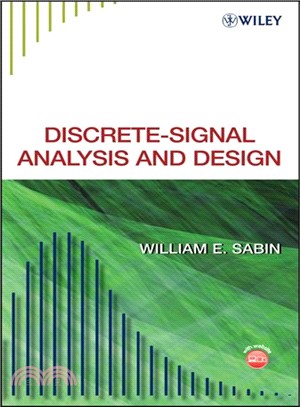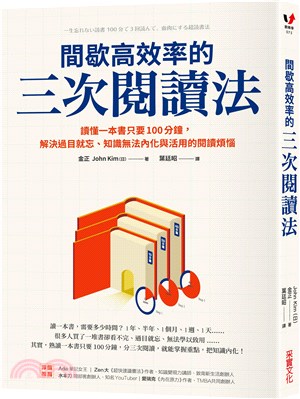Discrete-Signal Analysis And Design
- ISBN13:9780470187777
- 出版社:John Wiley & Sons Inc
- 作者:Sabin
- 裝訂/頁數:精裝/192頁
- 規格:24.1cm*16.5cm*1.9cm (高/寬/厚)
- 出版日:2008/01/22
定 價:NT$ 9088 元
優惠價:90 折 8179 元
若需訂購本書,請電洽客服 02-25006600[分機130、131]。
相關商品
商品簡介
作者簡介
名人/編輯推薦
目次
商品簡介
A clear, step-by-step approach to practical uses of discrete-signal analysis and design, especially for communications and radio engineers
This book provides an introduction to discrete-time and discrete-frequency signal processing, which is rapidly becoming an important, modern way to design and analyze electronics projects of all kinds. It presents discrete-signal processing concepts from the perspective of an experienced electronics or radio engineer, which is especially meaningful for practicing engineers, technicians, and students. The approach is almost entirely mathematical, but at a level that is suitable for undergraduate curriculums and also for independent, at-home study using a personal computer.
Coverage includes:
First principles, including the Discrete Fourier Transform (DFT)
Sine, cosine, and theta
Spectral leakage and aliasing
Smoothing and windowing
Multiplication and convolution
Probability and correlation
Power spectrum
Hilbert transform
The accompanying CD-ROM includes Mathcad® v.14 Academic Edition, which is reproduced with permission and has no time limitation for use, providing users with a sophisticated and world-famous tool for a wide range of applied mathematics capabilities.
Discrete-Signal Analysis and Design is written in an easy-to-follow, conversational style and supplies readers with a solid foundation for more advanced literature and software. It employs occasional re-examination and reinforcement of particularly important concepts, and each chapter contains self-study examples and full-page Mathcad® Worksheets, worked-out and fully explained.
This book provides an introduction to discrete-time and discrete-frequency signal processing, which is rapidly becoming an important, modern way to design and analyze electronics projects of all kinds. It presents discrete-signal processing concepts from the perspective of an experienced electronics or radio engineer, which is especially meaningful for practicing engineers, technicians, and students. The approach is almost entirely mathematical, but at a level that is suitable for undergraduate curriculums and also for independent, at-home study using a personal computer.
Coverage includes:
First principles, including the Discrete Fourier Transform (DFT)
Sine, cosine, and theta
Spectral leakage and aliasing
Smoothing and windowing
Multiplication and convolution
Probability and correlation
Power spectrum
Hilbert transform
The accompanying CD-ROM includes Mathcad® v.14 Academic Edition, which is reproduced with permission and has no time limitation for use, providing users with a sophisticated and world-famous tool for a wide range of applied mathematics capabilities.
Discrete-Signal Analysis and Design is written in an easy-to-follow, conversational style and supplies readers with a solid foundation for more advanced literature and software. It employs occasional re-examination and reinforcement of particularly important concepts, and each chapter contains self-study examples and full-page Mathcad® Worksheets, worked-out and fully explained.
作者簡介
William E. Sabin, MSEE, Life Member IEEE, has worked at a professional engineering level in the electronics industry for forty years in almost all areas of signal processing, including analog, discrete, and digital. He has coedited three books on the subject of radio systems and circuits and is the author of about forty technical articles in electronics journals.
名人/編輯推薦
"This volume is valuable for students, academic libraries, mathematicians, and working professionals, especially Mathead users." (CHOICE, August 2008)
目次
Introduction.
1. Define the goals of the book.
2. Define discrete signals.
3. The advantages of discrete-signal analysis and design.
4. Describe the DFT and IDFT.
5. Discuss the Mathcad program.
6. Discuss MATLAB and less expensive approaches.
7. Discuss Multisim program from National Instruments Co.
8. Discuss the Mathtype program.
9. Mention LabVIEW.
10. Mention Search Engines.
11. Discuss the personal productivity software capability.
Chapter 1: First Principles
1. Sequence structure in time domain and frequency domain.
2. Two-sided time and frequency.
3. The discrete Fourier transform.
4. The inverse discrete Fourier transform.
5. Frequency and time scaling.
6. Number of samples needed.
7. Complex frequency domain sequences. The phasor concept.
8. Time x(n) vs frequency X(k).
Chapter 2: Sine, Cosine and Theta.
1. One-sided sequences.
2. Combinations of two-sided phasors
3. Time and spectrum transformations.
4. Transforming two-sided phasor sequences into one-sided sine, cosine, Θ.
5. Example 2-1, nonlinear amplifier distortion and square law modulator.
6. Example 2-2, analysis of the ramp function.
Chapter 3: Spectral Leakage and Aliasing.
1. Spectral leakage. Non-integer values of time and frequency.
2. Scaling of frequency reduces leakage. Example 3-1.
3. Aliasing in the two-sided frequency domain.
4. Aliasing in the positive frequency domain.
5. Example 3-2. Analysis of frequency domain aliasing.
6. Time domain aliasing.
Chapter 4: Smoothing and Windowing.
1. Smoothing the rectangular window, without noise and with noise.
2. Smoothed sequences near the beginning and end.
3. Signal to noise ratio of a smoothed sequence.
4. Three-point smoothing and seven point smoothing.
5. Windowing in the time and frequency domains.
6. The rectangular window (review Ch. 3).
7. The Hamming Window.
8. The Hanning (Hann) Window.
9. Relative merits of the three windows.
10. Lobe amplitudes of the three types of windows.
11. Behavior of windows near k = 1 and 2.
12. Scaling the windows for improved frequency resolution.
Chapter 5: Multiplication and Convolution
1. Sequence multiplication.
2. Polynomial multiplication.
3. Discrete Convolution basic equation.
4. Relating convolution to polynomial multiplication.
5. The “fold and slide” concept.
6. Circular discrete convolution (try to avoid).
7. Sequence time and phase shift.
8. The DFT and IDFT of discrete convolution.
9. Fig 5-6. Compare convolution and multiplication.
10. De-convolution.
Chapter 6: Probability and Correlation
1. Expected value of noiseless sequence.
2. Include some additive noise.
3. Envelope detection of noisy sequence.
4. Power of noiseless sequence.
5. Power of noisy sequence.
6. Sequence averaging.
7. Variance (AC component).
8. Gaussian (normal) distribution.
9. Cumulative distribution (CDF).
10. Autocorrelation of a sequence.
11. Cross correlation of two sequences.
12. Auto-covariance.
13. Cross-covariance.
14. Correlation coefficient.
Chapter 7: Power spectrum.
1. Finding the power spectrum using Eq 7-1.
2. Two-side phasor spectrum, one-side power spectrum.
3. Example 7-1. See Fig 7-2.
4. Random Gaussian noise spectrum.
5. Measuring power spectrum.
6. Spectrum analyzer example.
7. Wiener-Kintchine theorem.
8. System power transfer Eq 7-6.
9. Cross power spectrum.
10. Example of calculating phase noise.
Chapter 8: Hilbert Transform.
1. The perfect Hilbert transformer.
2. Example of a Hilbert transform of a square wave.
3. Illustrate smoothing of the Example.
4. Explanation of peaks in Hilbert of square wave.
5. Mathematics of the Hilbert transform.
6. The analytic signal.
7. Example of construction of analytic signal.
8. Single-sideband RF signals.
9. SSB design.
10. The basic all-pass network.
11. -90° cascaded phase shift audio network.
12. Why the -90° network is not equivalent to a Hilbert transformer.
13. Filter method SSB transmitter.
14. Phasing method SSB receiver.
15. Filter method SSB receiver.
Appendix A: Additional discrete-signal information
16. Discrete derivative.
17. State variable solutions.
18. Using the discrete derivative.
Glossary.
Index.
1. Define the goals of the book.
2. Define discrete signals.
3. The advantages of discrete-signal analysis and design.
4. Describe the DFT and IDFT.
5. Discuss the Mathcad program.
6. Discuss MATLAB and less expensive approaches.
7. Discuss Multisim program from National Instruments Co.
8. Discuss the Mathtype program.
9. Mention LabVIEW.
10. Mention Search Engines.
11. Discuss the personal productivity software capability.
Chapter 1: First Principles
1. Sequence structure in time domain and frequency domain.
2. Two-sided time and frequency.
3. The discrete Fourier transform.
4. The inverse discrete Fourier transform.
5. Frequency and time scaling.
6. Number of samples needed.
7. Complex frequency domain sequences. The phasor concept.
8. Time x(n) vs frequency X(k).
Chapter 2: Sine, Cosine and Theta.
1. One-sided sequences.
2. Combinations of two-sided phasors
3. Time and spectrum transformations.
4. Transforming two-sided phasor sequences into one-sided sine, cosine, Θ.
5. Example 2-1, nonlinear amplifier distortion and square law modulator.
6. Example 2-2, analysis of the ramp function.
Chapter 3: Spectral Leakage and Aliasing.
1. Spectral leakage. Non-integer values of time and frequency.
2. Scaling of frequency reduces leakage. Example 3-1.
3. Aliasing in the two-sided frequency domain.
4. Aliasing in the positive frequency domain.
5. Example 3-2. Analysis of frequency domain aliasing.
6. Time domain aliasing.
Chapter 4: Smoothing and Windowing.
1. Smoothing the rectangular window, without noise and with noise.
2. Smoothed sequences near the beginning and end.
3. Signal to noise ratio of a smoothed sequence.
4. Three-point smoothing and seven point smoothing.
5. Windowing in the time and frequency domains.
6. The rectangular window (review Ch. 3).
7. The Hamming Window.
8. The Hanning (Hann) Window.
9. Relative merits of the three windows.
10. Lobe amplitudes of the three types of windows.
11. Behavior of windows near k = 1 and 2.
12. Scaling the windows for improved frequency resolution.
Chapter 5: Multiplication and Convolution
1. Sequence multiplication.
2. Polynomial multiplication.
3. Discrete Convolution basic equation.
4. Relating convolution to polynomial multiplication.
5. The “fold and slide” concept.
6. Circular discrete convolution (try to avoid).
7. Sequence time and phase shift.
8. The DFT and IDFT of discrete convolution.
9. Fig 5-6. Compare convolution and multiplication.
10. De-convolution.
Chapter 6: Probability and Correlation
1. Expected value of noiseless sequence.
2. Include some additive noise.
3. Envelope detection of noisy sequence.
4. Power of noiseless sequence.
5. Power of noisy sequence.
6. Sequence averaging.
7. Variance (AC component).
8. Gaussian (normal) distribution.
9. Cumulative distribution (CDF).
10. Autocorrelation of a sequence.
11. Cross correlation of two sequences.
12. Auto-covariance.
13. Cross-covariance.
14. Correlation coefficient.
Chapter 7: Power spectrum.
1. Finding the power spectrum using Eq 7-1.
2. Two-side phasor spectrum, one-side power spectrum.
3. Example 7-1. See Fig 7-2.
4. Random Gaussian noise spectrum.
5. Measuring power spectrum.
6. Spectrum analyzer example.
7. Wiener-Kintchine theorem.
8. System power transfer Eq 7-6.
9. Cross power spectrum.
10. Example of calculating phase noise.
Chapter 8: Hilbert Transform.
1. The perfect Hilbert transformer.
2. Example of a Hilbert transform of a square wave.
3. Illustrate smoothing of the Example.
4. Explanation of peaks in Hilbert of square wave.
5. Mathematics of the Hilbert transform.
6. The analytic signal.
7. Example of construction of analytic signal.
8. Single-sideband RF signals.
9. SSB design.
10. The basic all-pass network.
11. -90° cascaded phase shift audio network.
12. Why the -90° network is not equivalent to a Hilbert transformer.
13. Filter method SSB transmitter.
14. Phasing method SSB receiver.
15. Filter method SSB receiver.
Appendix A: Additional discrete-signal information
16. Discrete derivative.
17. State variable solutions.
18. Using the discrete derivative.
Glossary.
Index.
主題書展
更多主題書展
更多書展本週66折
您曾經瀏覽過的商品
購物須知
外文書商品之書封,為出版社提供之樣本。實際出貨商品,以出版社所提供之現有版本為主。部份書籍,因出版社供應狀況特殊,匯率將依實際狀況做調整。
無庫存之商品,在您完成訂單程序之後,將以空運的方式為你下單調貨。為了縮短等待的時間,建議您將外文書與其他商品分開下單,以獲得最快的取貨速度,平均調貨時間為1~2個月。
為了保護您的權益,「三民網路書店」提供會員七日商品鑑賞期(收到商品為起始日)。
若要辦理退貨,請在商品鑑賞期內寄回,且商品必須是全新狀態與完整包裝(商品、附件、發票、隨貨贈品等)否則恕不接受退貨。
























